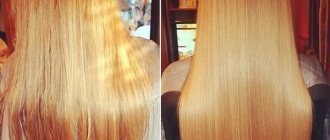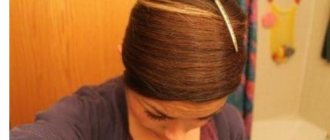Many ladies, as the date of their next hair removal approaches, often ask a silent question in their heads - “who came up with the idea that we should be smooth?!” And then, after the procedure, feeling smooth and light, they understand that it was not in vain that they came up with this practice.
If now there are many methods of hair removal and they are all relatively harmless, then previously unwanted vegetation was removed using cruel methods - burned with fire or hot ash. Can you tell me where this wildness comes from? After all, hair removal was practiced back in Ancient Egypt, when neither sugaring nor laser hair removal existed. Moreover, not only women, but also men removed hair. In equal proportions. All upper-class men were expected to have smooth skin.
But it is worth noting that there is one problem from this procedure, namely ingrown hairs. This difficulty is encountered by 1/3 of people using the procedure. Read more about them.
General information
Ingrown hairs appear due to a change in their growth, when the shaft remains under the skin without breaking through the skin, and its growth occurs in the opposite direction. As a rule, this phenomenon, which is also called pseudofolliculitis , develops in those places where a person often removes unwanted hair.
Most often, this is observed on the face, legs, pubic area, and armpit area. In places where pseudofolliculitis develops, swelling and redness appear, and the skin may itch. Later, scars and pigmentation may remain in these places. Therefore, although such a disease is not dangerous, it can be quite unpleasant and cause significant discomfort. Very often, this phenomenon is observed in people of the Negroid race, as well as in those whose hair is very coarse. If such a problem is observed in certain areas of the skin, a person needs to reconsider the methods of dealing with unwanted hair and prefer professional hair removal methods.
How to overcome this problem and what to do if a person develops pseudofolliculitis will be discussed in this article.
Why does hair grow ingrown?
Once removed, hair sometimes cannot find the right path back to the surface of the skin and grows just under the top layer of skin. More often, this problem occurs when plucking with an epilator, which breaks the hairs, the hair follicles weaken and do not allow new hairs to come out.
There are ways to prevent this unsightly picture. An excellent way to prevent ingrown hairs is to regularly exfoliate and remove dead cells that remain on the surface of the skin. For this purpose, mechanical and enzymatic peelings are used. Growing hair has more opportunity to penetrate the top layer of skin. However, sometimes this does not help and the hairs continue to grow inside the skin.
Another way is to change the way you epilate. Some hairs begin to grow in only after waxing, but shaving does not cause such problems. Some people get rid of the problem by starting to use hair removal creams. An effective remedy against ingrown hairs can be found here. Try different methods and maybe get rid of the need to pull out ingrown hairs. It is not known exactly why some people constantly suffer from ingrown hairs, regardless of their removal technique. The hair just can't find a way out.
Today, there are many methods for eliminating ingrown hairs. If none of the methods helps, then it is better to use laser hair removal.
Pathogenesis
The development of pseudofolliculitis is due to the fact that the growth of follicle hairs is prevented by the skin or epithelium. As a result, the hair does not grow straight, but begins to grow into the surrounding skin. This provokes an inflammatory reaction, redness and irritation of the skin. of microabscesses , as well as infiltrate , which appears as a reaction to a foreign body, may occur Sometimes psefdofolliculitis leads to fibrosis of the dermis, which leads to the appearance of papules, pustules, and hyperpigmentation. Sometimes, after an advanced ingrowth is removed, scars remain on the skin.
Non-invasive treatment
An antibacterial ointment based on erythromycin (40 rubles), clindamycin (Dalacin gel 850 rubles) or benzoyl peroxide (Baziron 800 rubles) is applied to the skin to relieve inflammation, i.e. relieving redness and swelling (1-2 days).
Then the skin is steamed and the dead epidermis is exfoliated using a scrub:
- You can buy a ready-made salt scrub at the pharmacy.
- Or use this recipe for a homemade scrub - 0.5 kg of table salt, 1 package of turmeric and 200 ml of vegetable oil (mix everything).
- Coffee scrub - 3 teaspoons of vegetable oil, 2 cups of ground coffee or coffee grounds, half a glass of sugar, mix everything.
After thoroughly rinsing the affected area and following this procedure, the hair is released immediately or in the next 24 hours. If necessary, repeat the procedure.
You can try this method:
- Chlorhexidine or hydrogen peroxide (2 parts), badyaga ointment (1 part), stir and apply for 5 minutes only to the problem area, then rinse thoroughly. This method is not suitable in all cases and not for everyone, since badyaga promotes hair growth.
When inflammation begins:
- You can buy Skinoren gel or any acne remedy with salicylic acid at the pharmacy.
Classification
Depending on the characteristics of development, the following varieties are distinguished:
- Pseudofolliculitis with hairs ingrown close to the surface of the skin.
- Pseudofolliculitis with deep hair growth.
Depending on the manifestations, there are:
- Ingrown hair in the form of an abscess.
- In the form of swelling with redness.
Depending on location:
- On the face
- On the neck.
- On foot.
- In the pubic area.
- In the armpit area.
- On the back (in infants).
Self-removal of ingrown hair at home
Step-by-step instructions will help us remove ingrown hair at home. For this manipulation, you need to stock up on a thin sterile needle (if the hair has grown deeply) and manicure tweezers. Before starting the procedure, medical tweezers must be treated with medical alcohol or an antiseptic (chlorhexedine).
- We steam the skin in the shower to expand the pores as much as possible. Using a scrub, we get rid of the dead layer of skin.
- The area of the ingrown hair is also treated with alcohol or an antiseptic.
- You need to find the tip of the hair and carefully pick it up with a needle, slowly pulling it out, clamp the protruding hair with tweezers and pull it out by the roots. At this stage, it is extremely important not to break off the hair and remove it entirely, otherwise it will grow back.
- Lubricate the skin with an antiseptic or, better yet, an alcohol tincture of calendula, which has an anti-inflammatory effect.
This method is suitable only in situations where ingrown hairs are clearly visible.
Causes
In most cases, the cause of ingrown hairs is depilation performed at home. When using a razor, creams, wax or epilator, only that part of the hair that is visible above the skin is removed. But the bulbs remain unharmed. Each time, after another depilation, the hair becomes weaker. At the same time, the stratum corneum of the epidermis closes the openings of the hair follicles. As a result, the hair cannot break through and grows into the skin.
The frequency of such manifestations is influenced by the following factors:
- Improper conduct of the depilation process - shaving against growth, using dull machines, too frequent depilation, etc.
- Lack of skin preparation for depilation and care after this procedure.
- Features of the skin – dryness, too thick layer of epidermis.
- Hair hardness, depth of hair follicles.
- Genetic disposition.
- Hormonal disorders - increased estrogen during a certain period of the monthly cycle, endocrine disorders, etc.
Ingrown hairs in the bikini area can appear due to regular wearing of not very comfortable underwear. If you regularly depilate your pubic region, the prerequisites for ingrown hairs appear. When wearing underwear made of synthetic materials, moisture does not evaporate from the surface of the skin, and as a result, bacterial infections can develop. As a result, you will notice that the ingrown hair in the bikini area has become a lump. As a rule, ingrown hairs become a lump when infectious processes develop. That is why after depilation you should not wear underwear made from non-natural materials.
Laser hair removal: double care for smooth skin (laser treatment for ingrown hairs)
Ladies' life is full of secrets and all kinds of worries. Among them is self-care. The desire to always remain beautiful takes a lot of effort and time. One of the most meticulous tasks is turning a furry part of the body into a smooth and delicate surface that you want to caress. Removing excess hair is a tedious procedure. And very often you have to pay with beauty for invading the natural process of hair growth. Pseudofolliculitis (ingrown hair) is the price you pay for smooth skin.
"No women - no tears." This is the popular interpretation of the famous song by Bob Marley: the sunny singer of Jamaica. Well, that's partly true. But only partly. Let’s paraphrase the great reggae hit in order to express more clearly one of the reasons for ladies’ tears.
“No shaving – no ingrown hairs!” This is the sad truth, realized by many women from their own experience. Who would know how many tears girls shed while struggling with the unpleasant consequences of hair removal!
But should you stop shaving after that? Leave everything as it is: both excess hair and ingrown hairs? Brush away your tears, girls. Laser medicine will help answer these questions. To begin with, let’s understand a little about the phenomenon of ingrown hairs.
Nature of ingrown hair
The prospect of ingrowth appears in any hair that is subjected to trauma (mechanical stress). The free edge of the hair becomes even stiffer and quite sharp. Everyone knows about this: hair that grows on a shaved surface is always prickly to the touch.
A short stub of hair, unlike a long hair, tends to curl in the opposite direction: that is, towards the skin. By piercing it, it naturally continues its growth. But now in unnatural conditions: under the skin.
Another cause of ingrown hairs is excessive roughness of the skin. It occurs due to insufficient attention to one's body. In such a situation, the too strong stratum corneum becomes an obstacle for the growing hair to come out. Unable to overcome the barrier, the hair curls up in the hair follicle or grows along the skin surface.
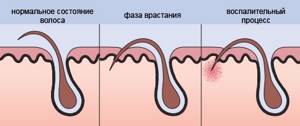
Only vellus hair, which is particularly soft and thin, is not able to grow under the skin.
Manifestations of ingrown hair
Early:
- irritation (redness) of the skin
- swelling
- local inflammatory process
- the appearance of dense painful rashes at the site of ingrown hair: papules (inflamed nodules) and pustules (purulent acne)
Late (complicated):
- appearance of pigment spots
- scarring of inflamed tissue
Causes of pseudofolliculitis:
- depilation (shaving, chemical depilation)
- hair removal (electrolysis, waxing, sugaring)
- violation of shaving technique (shaving against hair growth, using a razor with a dull blade, repeated shaving movements in the same place, ignoring moisturizing and softening foams/gels before and after shaving, shaving too often)
- depilation on rough areas of skin with a thick stratum corneum
- removal of coarse and curly hair (on legs, pubic area, armpits)
Areas of greatest ingrown hair
Ingrown hair can appear on any part of the human body that is periodically subjected to removal of unwanted hair. But the most favorable conditions for ingrowth are those places where the hair is stiff and curly:
- armpits
- legs
- bikini area
- the lower part of the face, which goes into the neck (beard growth area in men)
Both treatment and prevention
When all available means have been tried, when nothing brings relief, but only aggravates the situation, advanced medical technologies come to the rescue.
However, you should not test your skin’s strength – and resort to laser only as a last resort, when other methods of dealing with ingrown hairs do not produce results. Today it is reliably known that laser hair removal is the most effective, painless, sterile, fast and reliable way to get rid of pseudofolliculitis. And this is not only treatment, but also prevention. After all, laser removal of unwanted hair never causes such a side effect as ingrown hairs.
Laser hair removal
The operation of all hair removal lasers is based on the principle of selective photothermolysis. Its essence is a selective effect, when the thermal energy of a laser pulse is absorbed exclusively by the target cell. Such chromophores, capable of reacting to light during epilation, are two structural elements of human skin: dark pigment (melanin) and blood. Find out more information about lasers in the article “Types of lasers used for hair removal and hair removal.”
Melanin is found in the hair shaft and in its root (hair follicle). Blood circulates in small vessels that feed the follicle: the hair follicle surrounding the bulb. The laser does not see hair that is too light, vellus or gray due to the lack of melanin in it. But pigmented hair is a conductor for the laser. Absorbing heat, it lets the beam approach the root. Light energy heats the blood in the vessels. The blood clots (coagulates) - and the vessel sticks together (sclerosis). Without nutrition, the follicle gradually collapses and the hair falls out.
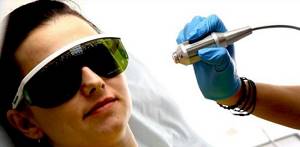
The situation with ingrown hairs improves significantly after 2-4 procedures. And completing a full hair removal course (about 8 sessions) will forever get rid of unnecessary hair - and prevent the ingrowth of single hairs remaining on the body.
Unlike mechanical hair removal, which gradually makes hair coarser, laser hair removal softens and thins it over time. Such hair is not at risk of ingrown hairs. Over time they will simply fall out. And the skin will become smooth: only vellus hair will remain on it. This softening is the preventative essence of laser hair removal.
In fairness, it is worth noting that photoepilation is no less effective than laser hair removal. It is also painless, atraumatic, and does not at all provoke the appearance of ingrown hairs. A camera, like a laser, simultaneously prevents the occurrence of complications after hair removal - and treats what has already made itself felt.
Both laser hair removal and phototherapy give the skin an associated rejuvenating effect.
Lasers for ingrown hair removal
All hair removal lasers are equally effective. It cannot be said that any one is superior to the others. The difference lies in the intended use of a certain category of patients.
Alexandrite laser hair removal gives excellent results on fair (untanned) skin with moderately dark hair. Also, alexandrite can work well with other color parameters of appearance. A neodymium laser epilator is indispensable for dark (tanned) skin with coarse dark hair. Let us remember that it is precisely this kind of hard hair that tends to grow into the skin. Diode laser – universal purpose. It perfectly removes hair from both dark and light skin. The ruby laser, although considered outdated, epilates light skin with dark hair well.
However, practice has made it possible to find out the names of laser systems that cope with epilation of ingrown hairs especially successfully:
- multifunctional GentleMax system, including GentleLASE 755 nm and Nd:YAG 1064 nm lasers, (Candela Corporation, USA)
- FriendlyLight Neo, 1064 nm (Aerolase, USA)
- LightSheer ET/ST, 790-830 nm (Lumenis, USA)
- diode laser 435-II, 810 nm (MedArt, Denmark)
- ClearScan (ALX 755 nm and YAG 1064 nm), (Sciton, USA)
Result
- long-term removal of unwanted and ingrown hairs
- relief of inflammatory processes of the skin
- improving the appearance and general condition of the skin
- rapid healing of pseudofollicular papules and pustules
- elimination of pigmented areas and scar formations (within 3-6 months)
As you can see, laser hair removal highly effectively treats already developed pseudofolliculitis. And at the same time, it reliably protects against it. True double protection. In this case, aren’t there enough arguments in its favor? Ingrown hairs, of course, do not pose a serious and direct threat to human health. But, as you know, any disease - both difficult and fairly harmless - is always better to prevent than to treat later.
Let's think again about the music of the small West Indian island. Of course, it has nothing to do with laser medicine. In addition to the curious fact that representatives of the black race are most prone to pseudofolliculitis. And also a song. "Don't cry, woman!" This is how it actually translates. Don't cry under any circumstances! Only fortitude and a kind heart will help you overcome difficulties. And such a small tragedy as ingrown hair can be easily and simply dealt with by laser hair removal.
Sign up for a free consultation right now, or leave a request and we will contact you and answer all your questions
Leave a request for a call Make an appointment
Symptoms
Hair can periodically grow in any place where unwanted hairs are periodically removed by some means. Most often, this phenomenon is observed on the legs, armpits, pubic area, neck and cheeks in men.
The main early signs of ingrown hair are the development of swelling and hyperemia. After some time, the development of the inflammatory process is noted. papules appear at the sites of ingrowth , which hurt and itch. In some cases, the tip of the hair may be visible through the skin. However, if a person tries to pull it out on their own with tweezers or another instrument, then an infection may end up getting inside the follicle. This leads to the formation of microabscesses. When the inflammatory process subsides, scars or pigmentation remain in its place.
Sometimes ingrown hairs come out on their own.
Symptoms of ingrown hairs
The list of main signs includes the following “signals” that the body gives us:
- hard formations appear, small, resembling bumps to the touch, their scientific name is papules,
- inflammatory process in the area of formations (redness), suppuration may begin,
- it is preceded by itching, dryness and discomfort in the area of inflammation.
We immediately warn you that it is undesirable to scratch the area of inflammation; you can scratch the area, injure the skin and cause an infection.
Ingrown hairs after hair removal in the photo do not look very aesthetically pleasing. Essentially, the body is showing us that something is wrong. If you feel pain in such areas, then you should worry and consult a doctor or cosmetologist. In addition to general inconvenience and itching, inflamed bumps do not look very pleasant or beautiful. In addition, neglected ulcers can cause a lot of reasons for concern in the future: for example, dirt may get into the wound. As a result, suppuration will intensify, damage to the deep layers of the epidermis will begin, and scars may appear, even due to one small point.
This phenomenon has a specific name and is called pseudofolliculitis. Dermatologists and cosmetologists use this term, but for ordinary people it’s just ingrown hairs and inflammation due to them. It should not be mistaken for a dangerous disease. To avoid such unwanted difficulties, we recommend that manipulations be carried out in aesthetic medicine clinics. This will help the specialist do preventive treatment of the area before and after the procedure. We'll talk about this a little later.
Tests and diagnostics
If pseudofolliculitis occurs regularly, you should visit a dermatologist. The doctor determines ingrown hairs visually by external signs. But in some cases, a specialist needs to exclude the presence of other pathologies. Therefore, he may order additional examinations.
Dermatoscopy is an instrumental examination that allows you to examine areas of the skin in multiple depths. In this case, manual optics or an automatic dermatoscope are used. This examination makes it possible to assess the condition of the skin and determine the specific signs of pseudofolliculitis.
Laboratory analysis of the contents of the abscess - this examination is relevant if the abscess constantly develops in one area. This study allows you to determine the causative agent of the infection.
During the diagnostic process, it is important to exclude a number of diseases: pyoderma , folliculitis , hyperkeratosis , acne .
Causes and symptoms
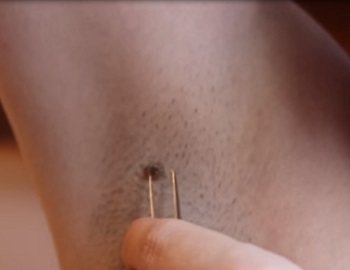
The problem occurs when the hairs that normally grow outward from the hair follicle are unable to penetrate the skin and begin to grow inward. This causes irritation and causes the skin to form bumps, pimples or pustules when the skin around the hair is infected or when the entire follicle is infected.
The condition where fluids accumulate and create bumps on the skin, caused by the inability of hair to grow properly, is known in medical terms as pseudo-folliculitis. It means that it is not exactly folliculitis, but the condition has similar symptoms.
Ingrown hairs can occur on different parts of the body as we have active hair follicles everywhere. But most people complain of this problem in the groin or pubic area, armpits, legs and face. They are often called by different names, such as razor bumps or razor bumps, which are often seen in men who shave their facial hair. In women, they are often found in the armpits and bikini area.
Although they can appear on different parts of the body, they have more or less the same reasons for their appearance.
Common reasons
Shaving and other hair removal methods
Shaving against the direction of natural hair growth can cause new hair growth to turn inward and begin to grow under the skin. Using dull or old razors is also suspected as a possible cause of this.
Using harsh hair removal methods such as waxing, which pulls the hair out by the roots, can also cause the hair to grow in a different direction. If this happens, ingrown hairs appear in the armpit.
Curly hair
You may be genetically predisposed to this problem if you have naturally curly hair. Latinos and people of Afro-Caribbean descent are more likely to suffer from this problem than people with straighter hair types. The more tightly the hair itself curls, the more likely it is that the hair will have a harder time growing in the right direction after shaving.
Clogged pores
If the pores through which new hair grows become clogged, the hair can turn and grow both inward and horizontally, becoming painful and ingrown. Dirt and sebum that accumulate in the pores can cause them to become clogged. Some cosmetics can also cause clogged pores.
Tight clothing and scratches can also lead to abnormal hair growth in the armpit area.
Symptoms
Sometimes ingrown armpit hairs or pseudo-folliculitis can cause large bumps or pimples with an abscess.
In other cases, you may see a rash in the area with ingrown hairs. It may also appear as a dark spot inside the pimple if you have dark hair. If the area around them is infected, you may see fluid inside the bump, making it white, yellow, or red, like acne.
Sometimes they form a large lump, which is also called an ingrown pilar cyst. It is often painful and can also cause tenderness and swelling of the lymph nodes in the armpit area.
Sometimes you may feel itching or tingling in the damaged area. However, lumps or bumps are one of the most common signs of ingrown hairs.
Treatment with folk remedies
Some traditional methods are also practiced, the use of which can reduce the frequency of the problem and make hair removal easier.
- Vinegar . Vinegar applications are used to soften and scrub the skin. It is necessary to mix vinegar and water in a 1:1 ratio. Use this product as a lotion - keep it on the affected area for about 10 minutes. Holding longer is not recommended to avoid burns. After this, you need to wipe the skin and apply cream to it.
- Warm compress . It can be used for ingrown hairs in the armpit area. To do this, take a sock and fill it with rice, beans or any cereal. Next, you should put it in the microwave and heat it up. Keep a warm compress on the affected area for 10-15 minutes.
- Baking soda . Stir 1 tbsp. l. baking soda in a glass of water and apply the solution to the affected area. After 10 minutes, rinse with water.
- Tea tree oil . Mix this product with water in a ratio of 1:5, mix and apply to the area where the hair is ingrown. After 15 minutes, gently wipe the skin.
- Bath with sea salt . You need to add 200 g of sea salt to warm water and sit in it for about 20 minutes. This procedure softens the skin.
Shave correctly and we will be beautiful...

If you are familiar with the problem of ingrown hairs firsthand, remember: a body scrub should become your best friend! By the way, you don’t have to spend money on expensive branded products: natural abrasives will do the job, for example, ground coffee, granulated sugar with coconut or olive oil, honey with coarse salt. The main thing is to ensure exfoliation: if you remove the dead layer of skin at least once a week, you can free ingrown hairs without even noticing it. In addition, you need to make sure that you are using a sharp enough razor - old razors give a poor cut and injure the skin. When shaving, you should not pull on the skin - and if you have to do this, go back to the line above: most likely, your razor has become dull. A good modern machine easily glides over the skin by itself: for example, the Dorco Shai 4 women's razor is equipped with a floating head, which allows it to get even into hard-to-reach places - the groin area and armpits. In addition, this machine has a rubber micro-comb that lifts the hairs before shaving, thereby ensuring an even cut. And, of course, under no circumstances should you shave hair on dry skin - even if you found yourself embarrassed at the last minute before leaving the house, when you had already put on a dress with straps.
Prevention
To prevent such problems, you should remember the following rules of prevention:
- Choose the right hair removal method. It's better to leave this to the professionals. If you remove it yourself, you should definitely carry out a procedure to soften and exfoliate the skin. The razor for removal should be sharp, and depilatory creams should be of high quality. You should not use shaving machines for a long time: this increases the likelihood of ingrown hairs.
- Shave hair in the direction it grows. When shaving, you should use foam or other special products.
- Use special lotions and creams after hair removal.
- Do not wear synthetic underwear after hair removal.
- Observe all rules of personal hygiene.
Prevention of ingrown hairs
It is best not to let hair grow into ingrown hairs, but to resort to prevention of this phenomenon. Before you begin to deal with the problem that appears after hair removal, you need to change the approach to the hair removal procedure. Agree, it is extremely stupid to constantly do the same actions and hope for a positive outcome.
Preventive measures aimed at preventing ingrown hairs:
• Shortly before hair removal, perform an exfoliating procedure (light peeling or scrubbing) to get rid of dead epidermal cells;
• Shaving should be carried out strictly in the direction of growth, but not in the other direction;
• After removal, it is important to carry out light scrubbing or peeling, which is then repeated several times over a couple of days;
• After any depilation, be it shaving, waxing or sugaring, you should apply a special product that slows hair growth or at least a moisturizer to the skin.
• After epilation is finished, do not wear uncomfortable synthetic underwear, as this may lead to relapse.
Diet
Diet for skin diseases
- Efficacy: therapeutic effect after a month
- Time frame: three months or more
- Cost of products: 1400-1500 rubles per week
Food should be varied and nutritious. It is important to avoid deficiencies of minerals, vitamins and other beneficial substances in order to prevent problems with the skin, as well as other organs and systems of the body.
The menu must include vegetables and fruits in large quantities, meat, dairy products, and sea fish.
Treatment methods
Basically, if the abnormally growing hair is removed or extracted from under the skin, the discomfort, namely pain, itching and pus formation, is dramatically reduced or goes away completely. If an infection is present, treatment may take a little longer.
Sometimes an infection can develop after the hairs have been extracted. But this can be avoided by carefully taking care of the disturbing area of skin using sterile products.
While it is completely safe to properly pull out hair using tweezers or a sterilized needle, it is not recommended to pick at the skin to remove deep ingrown hairs.
You may need to see a doctor in severe cases of infection. Also, if the ingrown hair is very deep under the skin, surgery may be the only option to treat the problem. The doctor may also recommend certain antibacterial medications or treatment with antibiotics, topical or oral, if the infection is serious.
You can try to remove it at home if the hair is visible and shallow.
How to get rid of it at home?
Ingrown hairs left alone will sometimes break out on their own and heal without any intervention. If this bothers you, you can try to get rid of this trouble using a simple method.
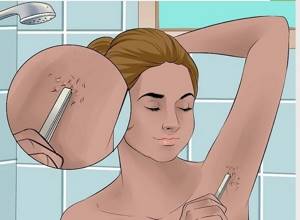
For extraction, you can use disinfected tweezers or a needle.
- Avoid shaving under your armpit when you notice an ingrown hair to avoid further irritating the area.
- If itching is present, hydrocortisone ointment may provide relief.
- Wait until the loop or tip begins to peek out a little from the skin or is almost under it.
- Wash your armpits and apply a warm compress to the affected area.
- Disinfect tweezers or needles with alcohol.
- Gently release the hair by pulling the loop or tip, avoiding damaging the swollen area around it.
- You can apply an antibiotic cream to prevent infection or use a disinfectant diluted with water.
Don't try to pull out hair that is still too deep! If after removal there remains a hole that does not heal for a long time, you should consult a doctor.
Home Remedies
Most home (folk) remedies that help get rid of this problem in other parts of the body will also work for the armpit area. These include:
- tea tree oil, lavender, castor oil;
- homemade scrubs, such as sugar and olive oil or oatmeal, honey and yogurt. But the easiest way is to just take sea salt;
- aloe vera, etc.
However, in most cases you will still have to remove the hair from under the skin. There are several ways to relieve symptoms naturally.
Applying a piece of bread soaked in warm milk is one of the home remedies known to bring the tip or "loop" closer to the surface. The hair can then be easily removed as above.
Rating of the best remedies for ingrown hairs for 2021
Our top selection of cosmetic products begins; they are not always able to fully cope with inflammation, but at the same time it is easier to find the best option among them.
Elseda Serum against ingrown hairs
This effective product contains AHA acids that can cope with even the most advanced problem. These substances in this product are represented by malic, lactic and salicylic acids. This composition not only protects against ingrown hairs, but also exfoliates dead cells, allowing for gentle peeling. The serum does not contain harsh abrasive components, therefore it is not capable of damaging the upper layer of the dermis, therefore, you can use this product in the cold winter season.
Regular use helps to even out skin tone and structure, cleanse pores, and smooth out small scars. Lactic acid has an extremely positive effect on the condition of the epidermis, healing inflammation, acne and post-acne. Pigment spots fade over time, and regeneration processes resume. The special composition of the serum is able to regulate the production of secretions from the sebaceous glands, preventing the appearance of new ingrowths. The use of the product is as follows: apply a small amount of serum to cleansed skin, then rinse it off after 20 minutes with warm water.
Elseda Serum against ingrown hairs
Advantages:
- positive effect on cellular metabolism;
- hypoallergenic, anti-inflammatory, soothing effects;
- versatility;
- acts gently;
- good composition.
Flaws:
- the effect is noticeable only after prolonged use.
The average cost is 660 Russian rubles.
Ingrow go, Skin Doctors
Do you want to purchase a product with the fastest possible effect? Then we recommend this product. This lotion is produced in Australia, the manufacturer brand has long earned an excellent reputation, so ladies can safely apply the product to problem areas. The special composition of the product is ideal for application to mature and sensitive skin.
The main effect of the product occurs 24 hours after its application. Inflammations and ingrown hairs disappear, and regular use will allow you to forget about irritation and rashes after shaving. The consistency of the product is oily, so it is better not to apply it to oily skin.
Ingrow go, Skin Doctors
Advantages:
- evens out skin tone;
- efficiency;
- suitable for men;
- economical use;
- fast action.
Flaws:
- Strong smell;
- high price;
- difficult to find on sale.
The average cost is 1,000 Russian rubles.
LET`S EPIL, Gloria
And another effective remedy that is popular with most consumers. The main active ingredients are special inhibitors that affect hair growth, and these inhibitors are able to delicately care for even the most sensitive dermis.
Also in the lotion, it is worth highlighting the presence of walnut extract, which penetrates the follicle, preventing hairs from growing into the skin. As moisturizing and nourishing ingredients, it is worth highlighting aloe vera, well-known for its beneficial qualities, and tea tree oil, which will help cope with inflammatory processes of the epidermis.
LET`S EPIL, Gloria
Advantages:
- good composition;
- many positive reviews;
- Suitable for all skin types;
- efficiency.
Flaws:
- uneconomical consumption;
- Suitable for prevention only.
The average cost is 600 Russian rubles.
Aravia Cream against ingrown hairs Professional with AHA acids
Currently, this is the best product that combines effectiveness and reasonable cost. The product contains AHA acids, known for their exfoliating properties. This cream can also be used as a post-hair removal treatment. In addition, the composition includes allantoin, which has a wound-healing and soothing effect.
Aravia Cream against ingrown hairs Professional with AHA acids
Advantages:
- efficiency;
- nice smell;
- good composition;
- moisturizes.
Flaws:
- uneconomical consumption;
- the dispenser pump often jams.
Aravia Enzyme cleansing powder against ingrown hairs
If you don't like oil, cream or gel products, try this unusual product. It is not presented in a thick liquid consistency, like most similar products, but in the form of a loose powder.
The main active ingredient is a valuable papaya enzyme, which will prepare the epidermis for depilation, as well as degrease the surface of the skin and remove dead cells from it. As for ingrown hairs, special enzymes added to the composition will cope perfectly with them. These enzymes destroy existing hairs and prevent new ones from forming. A pleasant bonus after use will be the depigmenting function.
Aravia Enzyme cleansing powder against ingrown hairs
Advantages:
- prepares the skin for hair removal;
- efficiency;
- ease of use.
Flaws:
- not enough moisture.
The average cost is 575 Russian rubles.
Hair Puller, Depilflax
The main components of the product include salicylic acid, which is one of the best drugs for inflammation. Thus, this product will not only prevent ingrowth, but will also relieve the unpleasant consequences of this problem. Since the main ingredient is somewhat aggressive towards the dermis, the product contains caring substances that can moisturize and nourish the epidermis.
The product is produced in Spain, the brand approached its development with full responsibility, creating a special formula that is suitable for use on the most sensitive skin.
Hair Puller, Depilflax
Advantages:
- efficiency;
- safety;
- relieves itching and irritation.
Flaws:
- difficult to find on sale;
- strong unpleasant aroma;
- relatively high price.
The average cost is 530 Russian rubles.
And now we present to your attention pharmaceutical ointments that allow you to fight ingrown hairs and their unpleasant consequences.
Levomekol

A well-known ointment that can cope with the most pronounced and painful suppurations. Of course, such a drug will not allow you to get rid of ingrown hairs or become a means of preventing this defect, however, the antibacterial properties will put the epidermis in order. Also keep in mind that the ointment is not intended for daily use; it should be applied locally with a specific course of treatment.
Levomekol
Advantages:
- efficiency;
- few side effects;
- budget price.
Flaws:
- there are contraindications;
- treats only inflammation;
- The antibiotic contained in the composition is able to penetrate the skin barrier into the bloodstream.
The average cost is 115 Russian rubles.
Salicylic ointment
This product has already been mentioned in our selection as one of the active ingredients. If you do not want to overpay for the brand and additional substances, you can purchase this ointment.
Just like the previous option, this product is intended for local local use to relieve the inflammatory process. It is also worth noting that this product has some toxicity, so dermatologists recommend mixing it with other creams, such as children's creams.
Salicylic ointment
Advantages:
- efficiency;
- low cost;
- fast action.
Flaws:
- there are contraindications;
- not recommended for use during pregnancy and lactation.
The average cost is 30 Russian rubles.
Ichthyol ointment
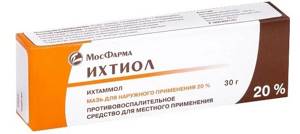
Another well-known and time-tested remedy. This drug can not only have anti-inflammatory and antiseptic effects, but also, when applied correctly, remove ingrown hairs from the skin.
How to use? A small amount of ointment should be applied to the damaged area, covered with a clean gauze pad, bandaged and left overnight.
Ichthyol ointment
Advantages:
- efficiency;
- antimicrobial effect.
Flaws:
- there are contraindications;
- extremely pungent and unpleasant odor.
The average cost is 70 Russian rubles.
Advice! It is recommended to mix any pharmaceutical ointments with extracts from valuable plants and essential oils. This way the intensity of the impact will increase significantly, moreover, you will be able to provide additional care for the epidermis.

